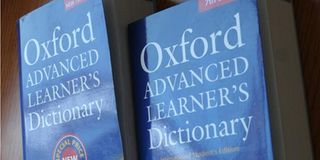An artist or an artiste, the ‘e’ makes a big difference

Copies of Oxford Advanced Learner's dictionary. PHOTO | PHOEBE OKALL | FIEL |
What you need to know:
- In England, the form artist (no “e”) came to mean any person who uses natural material to artifice a form which looks like any of the countless objects and phenomena that stud our natural surroundings.
- One form, artist (with no “e”), refers to all those who artifice from the landscape, including architects, cooks, dancers, thespians, farmers, novelists, couturiers, industrialists, journalists, musicians, painters and poets.
What is a “literary artiste”? Ask me another! Yet the term appeared in my own piece on Ali Mazrui (Saturday Nation, November 30, 2014). “Literary artist” (with no “e” at the end of the word artist) was the term I had used to describe Ngugi wa Thiong’o, the celebrated Kenyan story-teller.
But, since English has both forms, why did the sub-editor’s addition of the letter “e” to my original word artist annoy me so? Because it made me say something I had never said.
Both forms (artist and artiste) entered English, through French, from the Latin ars, which referred to any craftsmanship. The form artist probably embedded itself into English following the Norman French conquest of England in 1066. Most likely, too, England’s reborrowing of it as artiste — this time retaining the French orthography (with an “e”) — belonged to the Renaissance, Western Europe’s 16th-century upsurge of intellectual creation.
Why, then, did English need two forms of the same borrowing? The answer: In order to be able to express differently two closely related nuances of the same thought — though, of course, as with all such borrowings by all languages the world over, the borrowers were never too conscious that they were borrowing.
DISTORTS REALITY
In England, the form artist (no “e”) came to mean any person who uses natural material to artifice a form which looks like any of the countless objects and phenomena that stud our natural surroundings, thereby “mocking” that object or phenomenon. In the poem “Ozymandias”, Percy Bysshe Shelley speaks of “the hand that mocked” the Great pyramid on Egypt’s Giza plateau.
What the Hermetic English poet is telling us is that art is the fun both of producing a lookalike from nature and society and — because, in the process, the artist necessarily distorts the reality of his or her subject — of causing the onlooker to laugh or, at least, to smile or grin at this artistic exaggeration or distortion of reality.
What the Austrian art historian Ernst Fischer called the necessity of art consists in that such exaggerations are the mirror through which a society can most clearly see its realities — including its shortcomings, pin-headedness, grotesqueness, cruelties, injustices and other inadequacies — so as to deliberately take collective actions to transform those realities hopefully for the better.
GOOD INTENTIONS
It was, however, with good “intentions” that English also borrowed the French word artiste all complete with the “e”. One form, artist (with no “e”), refers to all those who artifice from the landscape, including architects, cooks, dancers, thespians, farmers, novelists, couturiers, industrialists, journalists, musicians, painters and poets.
The other form (artiste) retained the French “e” in order to be able to express a special, very circumscribed, semantic significance of the word art, namely, only such stage performers as dancers, movie stars, singers and thespians.
Let me reiterate this. Whereas Ngugi wa Thiong’o’ is an artist, Benson Wanjau (Ojwang Hatari of the television series Vitimbi) is an artiste. The point, however, is that both serve as mirrors of solutions to the same human problems.
Philip Ochieng is a veteran journalist





